Найдено аналитическое решение уравнения Пуассона для расчета электрического поля на поверхности электрода, погруженного в однородную неизотермическую бесстолкновительную плазму, состоящую из электронов и однозарядных ионов с зарядом e, с температурой электронов Te, при больших значениях отрицательного электрического потенциала , когда параметр |e| / Te >> 1. Установлено, что размер слоя L плазмы с нарушенной квазинейтральностью вблизи высокопотенциального электрода увеличивается по сравнению с радиусом Дебая rD пропорционально параметру [e / 2Te]3/4 , L = rD [e / 2Te]3/4. Показано, что в лабораторной плазме с плотностью в интервале значений 10101013 см3 и температурой электронов от 1 до 10 эВ при больших значениях потенциала и параметра e/Te >> 1 электрическое поле, рассчитанное по полученной формуле E = | L вблизи поверхности погруженного в плазму электрода, от 20 до 200 раз меньше значений полей, рассчитанных по классической формуле E = | rD, полученной при малых потенциала и при значениях параметра e / Te << 1.
An analytical solution of the Poisson equation is found for calculating the electric field on the surface of an electrode immersed in a homogeneous non-isothermal collisionless plasma consisting of electrons and single-charged ions with charge e, with electron temperature Te, at large values of negative electric potential , when the parameter |e|/Te >> 1. It is established that the size of the plasma layer L with disturbed quasi-neutrality near the high-potential electrode increases in com-parison with the Debye radius rD in proportion to the parameter [e/2Te]3/4, L= rD [e/2Te]3/4. It is shown that in a laboratory plasma with a density in the range of 10101013 cm3 and an electron temperature from 1eV to 10 eV at high values of the potential and parameter e/Te >> 1, the elec-tric field calculated by the obtained formula E = |L near the surface of the electrode immersed in plasma, from 20 to 200 times less than the values of the fields calculated by the classical formula E = |rD, obtained at low potentials and at the values of the parameter e/Te << 1.
Идентификаторы и классификаторы
- SCI
- Физика
- Префикс DOI
- 10.51368/2307-4469-2022-10-4-343-350
- eLIBRARY ID
- 49432930







